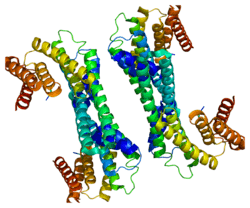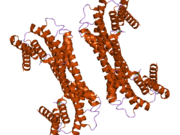YWHAH
14-3-3 protein eta is a protein that in humans is encoded by the YWHAH gene.
This gene product belongs to the 14-3-3 family of proteins which mediate signal transduction by binding to phosphoserine-containing proteins. This highly conserved protein family is found in both plants and mammals, and this protein is 99% identical to the mouse, rat and bovine orthologs. This gene contains a 7 bp repeat sequence in its 5' UTR, and changes in the number of this repeat has been associated with early-onset schizophrenia.[1]
Interactions
YWHAH has been shown to interact with TNFAIP3,[2][3] KLC3,[4] C-Raf,[3][4][5] Phosphoinositide-dependent kinase-1,[6] RIMS2,[7] KIF5B,[4] RIMS1,[7] CDC25B,[8] ZFP36,[9] EPB41L3,[10] Glucocorticoid receptor[11] and TLX2.[12]
References
- ↑ "Entrez Gene: YWHAH tyrosine 3-monooxygenase/tryptophan 5-monooxygenase activation protein, eta polypeptide".
- ↑ De Valck, D; Heyninck K; Van Criekinge W; Vandenabeele P; Fiers W; Beyaert R (September 1997). "A20 inhibits NF-kappaB activation independently of binding to 14-3-3 proteins". Biochem. Biophys. Res. Commun. (UNITED STATES) 238 (2): 590–4. doi:10.1006/bbrc.1997.7343. ISSN 0006-291X. PMID 9299557.
- ↑ 3.0 3.1 Vincenz, C; Dixit V M (August 1996). "14-3-3 proteins associate with A20 in an isoform-specific manner and function both as chaperone and adapter molecules". J. Biol. Chem. (UNITED STATES) 271 (33): 20029–34. doi:10.1074/jbc.271.33.20029. ISSN 0021-9258. PMID 8702721.
- ↑ 4.0 4.1 4.2 Ichimura, Tohru; Wakamiya-Tsuruta Akiko, Itagaki Chiharu, Taoka Masato, Hayano Toshiya, Natsume Tohru, Isobe Toshiaki (April 2002). "Phosphorylation-dependent interaction of kinesin light chain 2 and the 14-3-3 protein". Biochemistry (United States) 41 (17): 5566–72. doi:10.1021/bi015946f. ISSN 0006-2960. PMID 11969417.
- ↑ Van Der Hoeven, P C; Van Der Wal J C, Ruurs P, Van Dijk M C, Van Blitterswijk J (January 2000). "14-3-3 isotypes facilitate coupling of protein kinase C-zeta to Raf-1: negative regulation by 14-3-3 phosphorylation". Biochem. J. (ENGLAND) 345 (2): 297–306. doi:10.1042/0264-6021:3450297. ISSN 0264-6021. PMC 1220759. PMID 10620507.
- ↑ Sato, Saori; Fujita Naoya; Tsuruo Takashi (October 2002). "Regulation of kinase activity of 3-phosphoinositide-dependent protein kinase-1 by binding to 14-3-3". J. Biol. Chem. (United States) 277 (42): 39360–7. doi:10.1074/jbc.M205141200. ISSN 0021-9258. PMID 12177059.
- ↑ 7.0 7.1 Sun, Lei; Bittner Mary A; Holz Ronald W (October 2003). "Rim, a component of the presynaptic active zone and modulator of exocytosis, binds 14-3-3 through its N terminus". J. Biol. Chem. (United States) 278 (40): 38301–9. doi:10.1074/jbc.M212801200. ISSN 0021-9258. PMID 12871946.
- ↑ Mils, V; Baldin V; Goubin F; Pinta I; Papin C; Waye M; Eychene A; Ducommun B (March 2000). "Specific interaction between 14-3-3 isoforms and the human CDC25B phosphatase". Oncogene (ENGLAND) 19 (10): 1257–65. doi:10.1038/sj.onc.1203419. ISSN 0950-9232. PMID 10713667.
- ↑ Johnson, Barbra A; Stehn Justine R; Yaffe Michael B; Blackwell T Keith (May 2002). "Cytoplasmic localization of tristetraprolin involves 14-3-3-dependent and -independent mechanisms". J. Biol. Chem. (United States) 277 (20): 18029–36. doi:10.1074/jbc.M110465200. ISSN 0021-9258. PMID 11886850.
- ↑ Yu, Tingxi; Robb Victoria A; Singh Vinita; Gutmann David H; Newsham Irene F (August 2002). "The 4.1/ezrin/radixin/moesin domain of the DAL-1/Protein 4.1B tumour suppressor interacts with 14-3-3 proteins". Biochem. J. (England) 365 (Pt 3): 783–9. doi:10.1042/BJ20020060. ISSN 0264-6021. PMC 1222735. PMID 11996670.
- ↑ Wakui, H; Wright A P; Gustafsson J; Zilliacus J (March 1997). "Interaction of the ligand-activated glucocorticoid receptor with the 14-3-3 eta protein". J. Biol. Chem. (UNITED STATES) 272 (13): 8153–6. doi:10.1074/jbc.272.13.8153. ISSN 0021-9258. PMID 9079630.
- ↑ Tang, S J; Suen T C; McInnes R R; Buchwald M (September 1998). "Association of the TLX-2 homeodomain and 14-3-3eta signaling proteins". J. Biol. Chem. (UNITED STATES) 273 (39): 25356–63. doi:10.1074/jbc.273.39.25356. ISSN 0021-9258. PMID 9738002.
Further reading
- Kino T, Pavlakis GN (2004). "Partner molecules of accessory protein Vpr of the human immunodeficiency virus type 1.". DNA Cell Biol. 23 (4): 193–205. doi:10.1089/104454904773819789. PMID 15142377.
- Kino T, Chrousos GP (2004). "Human immunodeficiency virus type-1 accessory protein Vpr: a causative agent of the AIDS-related insulin resistance/lipodystrophy syndrome?". Ann. N. Y. Acad. Sci. 1024: 153–67. doi:10.1196/annals.1321.013. PMID 15265780.
- Ichimura-Ohshima Y, Morii K, Ichimura T et al. (1992). "cDNA cloning and chromosome assignment of the gene for human brain 14-3-3 protein eta chain.". J. Neurosci. Res. 31 (4): 600–5. doi:10.1002/jnr.490310403. PMID 1578511.
- Ichimura T, Isobe T, Okuyama T et al. (1988). "Molecular cloning of cDNA coding for brain-specific 14-3-3 protein, a protein kinase-dependent activator of tyrosine and tryptophan hydroxylases.". Proc. Natl. Acad. Sci. U.S.A. 85 (19): 7084–8. doi:10.1073/pnas.85.19.7084. PMC 282128. PMID 2902623.
- Ichimura T, Uchiyama J, Kunihiro O et al. (1996). "Identification of the site of interaction of the 14-3-3 protein with phosphorylated tryptophan hydroxylase.". J. Biol. Chem. 270 (48): 28515–8. doi:10.1074/jbc.270.48.28515. PMID 7499362.
- Jones DH, Ley S, Aitken A (1995). "Isoforms of 14-3-3 protein can form homo- and heterodimers in vivo and in vitro: implications for function as adapter proteins.". FEBS Lett. 368 (1): 55–8. doi:10.1016/0014-5793(95)00598-4. PMID 7615088.
- Wu C, Friedlander P, Lamoureux C et al. (1993). "cDNA clones contain autonomous replication activity.". Biochim. Biophys. Acta 1174 (3): 241–57. doi:10.1016/0167-4781(93)90193-h. PMID 7690594.
- Swanson KD, Dhar MS, Joshi JG (1993). "The human and bovine 14-3-3 eta protein mRNAs are highly conserved in both their translated and untranslated regions.". Biochim. Biophys. Acta 1216 (1): 145–8. doi:10.1016/0167-4781(93)90053-G. PMID 8218406.
- Leffers H, Madsen P, Rasmussen HH et al. (1993). "Molecular cloning and expression of the transformation sensitive epithelial marker stratifin. A member of a protein family that has been involved in the protein kinase C signalling pathway.". J. Mol. Biol. 231 (4): 982–98. doi:10.1006/jmbi.1993.1346. PMID 8515476.
- Muratake T, Hayashi S, Ichimura Y et al. (1996). "The effect on methamphetamine on the mRNA level for 14.3.3 eta chain in the human cultured cells.". Mol. Neurobiol. 11 (1-3): 223–30. doi:10.1007/BF02740697. PMID 8561965.
- Tommerup N, Leffers H (1996). "Assignment of the human genes encoding 14,3-3 Eta (YWHAH) to 22q12, 14-3-3 zeta (YWHAZ) to 2p25.1-p25.2, and 14-3-3 beta (YWHAB) to 20q13.1 by in situ hybridization.". Genomics 33 (1): 149–50. doi:10.1006/geno.1996.0176. PMID 8617504.
- Andersson B, Wentland MA, Ricafrente JY et al. (1996). "A "double adaptor" method for improved shotgun library construction.". Anal. Biochem. 236 (1): 107–13. doi:10.1006/abio.1996.0138. PMID 8619474.
- Papin C, Denouel A, Calothy G, Eychène A (1996). "Identification of signalling proteins interacting with B-Raf in the yeast two-hybrid system.". Oncogene 12 (10): 2213–21. PMID 8668348.
- Vincenz C, Dixit VM (1996). "14-3-3 proteins associate with A20 in an isoform-specific manner and function both as chaperone and adapter molecules.". J. Biol. Chem. 271 (33): 20029–34. doi:10.1074/jbc.271.33.20029. PMID 8702721.
- Muratake T, Hayashi S, Ichikawa T et al. (1997). "Structural organization and chromosomal assignment of the human 14-3-3 eta chain gene (YWHAH).". Genomics 36 (1): 63–9. doi:10.1006/geno.1996.0426. PMID 8812417.
- Wakui H, Wright AP, Gustafsson J, Zilliacus J (1997). "Interaction of the ligand-activated glucocorticoid receptor with the 14-3-3 eta protein.". J. Biol. Chem. 272 (13): 8153–6. doi:10.1074/jbc.272.13.8153. PMID 9079630.
- Yu W, Andersson B, Worley KC et al. (1997). "Large-scale concatenation cDNA sequencing.". Genome Res. 7 (4): 353–8. doi:10.1101/gr.7.4.353. PMC 139146. PMID 9110174.
- Peng CY, Graves PR, Thoma RS et al. (1997). "Mitotic and G2 checkpoint control: regulation of 14-3-3 protein binding by phosphorylation of Cdc25C on serine-216.". Science 277 (5331): 1501–5. doi:10.1126/science.277.5331.1501. PMID 9278512.
- De Valck D, Heyninck K, Van Criekinge W et al. (1997). "A20 inhibits NF-kappaB activation independently of binding to 14-3-3 proteins.". Biochem. Biophys. Res. Commun. 238 (2): 590–4. doi:10.1006/bbrc.1997.7343. PMID 9299557.
- Hsu SY, Kaipia A, Zhu L, Hsueh AJ (1997). "Interference of BAD (Bcl-xL/Bcl-2-associated death promoter)-induced apoptosis in mammalian cells by 14-3-3 isoforms and P11.". Mol. Endocrinol. 11 (12): 1858–67. doi:10.1210/me.11.12.1858. PMID 9369453.
| |||||||||||


